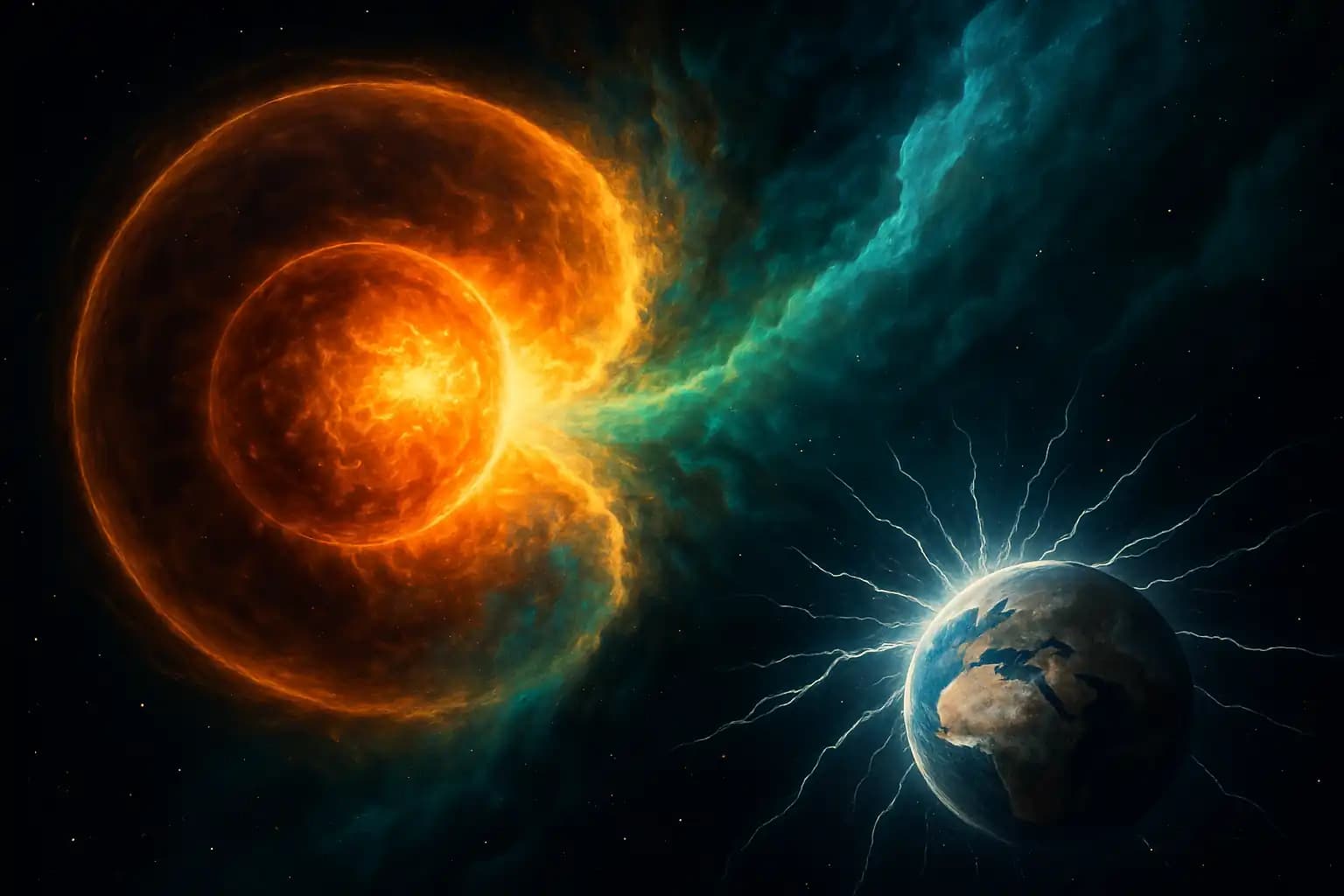I’m Art, your favorite bunker-broadcasting doom scout. I’ve got a fresh celestial curveball for your Tuesday night. Picture the Sun as a yellow school bus barreling down a foggy highway. Now imagine that the fog thickens into wet cement. That moment—when wheels meet sludge—is what astrophysicists fear as our star exits the Local Interstellar Cloud and rams into the mysterious G-cloud. In the lab, they call it a boundary transition. Down here, under three meters of reinforced concrete, I call it the galactic speed bump that could scramble every circuit you own.
Voyager 1 and 2 have already tasted the interstellar medium. They’re mere pinpricks compared to the bow wave that will hit the heliosphere if the G-cloud proves thicker than advertised. Radioisotope clues pulled from ancient ocean crust suggest similar encounters in deep time collapsed the Sun’s protective bubble all the way inside Earth’s orbit. Strip away that magnetic umbrella, and cosmic rays storm in like paparazzi at a royal scandal. The flashing lights can mutate DNA and melt transformers. Buckle up; the countdown may have started without an official press release.
Galactic Cartography: Mapping the Local Cloud to the G-Cloud
The Local Interstellar Cloud—our current galactic address—is a wispy blend of hydrogen and helium so thin that a cubic centimeter holds fewer atoms than the best vacuum on Earth. Even so, it shapes a magnetic reality that lets the heliosphere sprawl roughly 100 astronomical units from the Sun. Data in a seminal Astronomy & Astrophysics study suggests this cloud ends in a ragged boundary only a few thousand AU thick. On the other side lurks the G-cloud, a denser, colder plasma pocket whose chemistry remains guests-only until we physically arrive.
The Sun races around the Milky Way at 230 kilometers per second. That motion, combined with turbulence inside the Local Bubble, means we could nose into the G-cloud tomorrow—or graze it 1,800 years from now. Either way, the clock ticks. A recent model, spotlighted by geochemists studying iron-60 deposits, proposes that the Solar System’s previous brush with a dense cloud about two million years ago correlates with elevated cosmic-ray isotopes in Antarctic ice cores. If those fingerprints align with the G-cloud’s projected density, our children—or theirs—could witness a sky glittering with auroras as far south as Havana.
Internal chatter among astronomers reached the conspiracy boards faster than you can spell heliopause. Speculation piggybacks on archives like the-inevitable-unraveling-earths-failing-shield-and-the-rise-of-the-plasma-apocalypse-11252023, where plasma physicists and survivalist bloggers find rare common ground: both groups hate surprises in a high-energy environment.
Heliosphere Under Pressure: How a Cosmic Headwind Shrinks Our Bubble
Think of the heliosphere as a constantly inflating beach ball made of charged particles blasted out by the solar wind. On a normal day, that ball deflects most galactic cosmic rays, keeping Earth’s radiation dose tolerable. But if the surrounding medium thickens, outside pressure compresses the ball inward. According to cosmic-ray research, even a tenfold compression could increase low-energy particle flux at Earth by 200 percent. That’s the kind of exposure that forces flight crews into lead-lined jumpsuits and fries delicate triple-junction cells on communication satellites.
Remember the 2003 Halloween solar storms? Double that dosage without needing a flare. That scenario terrifies grid operators, who still curl up at night with reports like magnetic-mayhem-07172024, where engineers admit a Carrington-class event today would cost trillions. Substitute constant cosmic-ray drizzle for a one-off solar tantrum, and you get a chronic technical migraine that erodes hardware but never quite qualifies for an insurance payout.
The heliopause’s exact shape remains debated—some argue for a comet-like tail, others for a croissant—but everyone agrees it works because the solar wind outruns the interstellar wind. Densify that external plasma and the balance flips. Theoretical simulations at NASA’s Goddard Space Flight Center predict the nose of the heliosphere could yank inward to 0.5 AU. Yes, that’s inside Earth’s orbit, leaving us naked in the galactic wind like a tourist who lost luggage on an interstellar layover.
Radioisotope Time Capsules: Learning from Ancient Cosmic Ray Spikes
Evidence of past heliospheric collapses hides in sediments, tree rings, and even fossilized spores. Geologists track isotope anomalies—iron-60, plutonium-244, beryllium-10—that spike when cosmic-ray bombardment intensifies. A new Boston University study on seafloor crust, similar to the one discussed on south-atlantic-anomaly-sign-of-an-impending-cataclysm, pinpoints a dense-cloud crossing roughly 2.3 million years ago. Coincidentally, climate records show abrupt cooling and heightened extinction rates among marine megafauna at that same horizon.
Does correlation equal causation? Astrophysicists tread carefully, but the overlap undercuts any notion that cloud transitions are harmless. NASA’s upcoming Interstellar Probe concept, now in Phase A study, plans to launch in the 2030s. It could fly 1,000 AU within fifty years—fast enough to sample whatever soup floats beyond the heliopause. Until that data arrives, radioisotopes remain our forensic breadcrumbs, painting a picture too ominous for polite cocktail banter.
Even Silicon Valley is paying attention. Venture-capital decks flagged on ai-armageddon-the-digital-arsenal-that-might-just-save-us-11272023 pitch AI-driven shielding strategies for satellites and lunar outposts. Investors believe that if humans ever colonize Mars, they’ll need a radiation playbook written in advance—cloud transition or not.
Earthly Vulnerabilities: Power Grids, DNA, and the New Space Economy
Compress the heliosphere, and three terrestrial systems shiver first: electricity, biology, and billion-dollar rockets. Higher cosmic-ray flux seeds extra atmospheric ionization, thickening the global electric circuit. Transmission lines resonate and transformers overheat. The scenarios dramatized on border-blaze-07182024 look less like war gaming and more like Tuesday morning outages.
Increased muon and neutron flux shave safety margins for everything from aircrew to crop genetics. A 20 percent uptick in background radiation sounds modest until you multiply exposure across entire food chains. Evolution loves mutation; civilization, not so much. Expect insurance underwriters to revise actuarial tables the way meteorologists rewrote hurricane categories after Katrina.
Finally, the burgeoning space economy—hello, Starlink, lunar logistics, and asteroid miners—relies on electronics that already juggle single-event upsets. Cosmic-ray-hardened chips cost more and weigh more, so many startups gamble on today’s lower radiation budget. Enter the G-cloud, and those balance sheets bleed red ink faster than you can say oumuamua-mystery-06302024. Increased radiation can also charge vehicle skins and spark mid-flight discharges—a risk profile documented in ESA white papers but rarely advertised in investor brochures.
Preparing for the Galactic Weather Front
Can humanity insulate itself before the cosmic rainstorm? Researchers hope so. ESA’s Vigil mission aims to park a spacecraft at L5, providing a side-eye view of solar wind-interstellar interactions. The U.S. Interstellar Mapping and Acceleration Probe (IMAP), launching 2025, will analyze energetic neutral atoms to forecast heliospheric contraction—a cosmic Doppler radar of sorts.
On the ground, innovations in high-temperature superconducting cables promise self-healing grid architectures. Biotech firms test radiation-resistant CRISPR edits inspired by tardigrades. Those breakthroughs echo the resilience strategies explored on bunkered-beneath-07162024, where civil engineers weigh underground data centers against orbital backups.
Yet technology alone may not outrun galactic physics. The heliosphere’s health ties directly to solar wind pressure. A prolonged Maunder-like minimum during a cloud transition could deliver a one-two punch: weaker solar wind plus denser ambient plasma. The beach ball deflates just as the outside air turns into concrete. Space-weather specialists warn that policy makers must integrate heliophysical metrics into everything from nuclear-plant hardening to airline routing. Add “galactic environment” to your climate-risk disclosure forms; auditors will love it.
What Voyager, IBEX, and Future Probes Still Need to Learn
The twin Voyagers provided the first hard data on interstellar plasma, but their single-point measurements leave gaping blind spots. IBEX and NASA’s upcoming IMAP map energetic neutral atoms, providing indirect clues about pressure fronts ahead. Even so, we lack a 3-D weather map of the G-cloud. A proposed Interstellar Probe, championed by Johns Hopkins APL and chronicled on orbital-intruder-07142024, would streak above 7 AU per year, fast enough to pierce the cloud well before 2100. Its instruments could verify whether dense plasma pockets lurk or whether early fears mimic Y2K hysteria dressed in astrophysics garb.
In the meantime, bookmark this heliosphere primer and keep tabs on plasma-density models released by the IBEX team. Each update nudges probability curves on when—and how severely—the G-cloud handshake squeezes.
If that sounds abstract, remember: a single super-rich cosmic-ray event once knocked out the Japanese Hitomi X-ray observatory and cost taxpayers $300 million. Scale that to every satellite in low-Earth orbit, and you start to grasp why hedge funds now read space-weather bulletins with the zeal of day traders decoding Fed minutes.
Final Signal from the Bunker
Whether the G-cloud arrives in our lifetime or in humanity’s medieval cyber-descendant era, the physics remain non-negotiable. A denser interstellar medium compresses the heliosphere; a compressed heliosphere invites cosmic rays; cosmic rays don’t care about your quarterly earnings. That triad explains why a handful of astrophysicists, grid managers, and survivalists—groups that seldom share coffee—now pore over the same data sets.
I’ll keep broadcasting as long as the diesel holds out. Meanwhile, stash an extra Faraday bag for your phone, invest in surge protectors that actually ground, and visit Unexplained for updates the polite media won’t touch. When the galactic speed bump hits, you’ll want more than SPF 50 between you and the cosmos.




